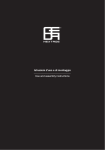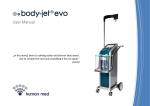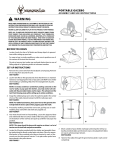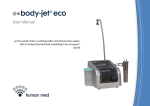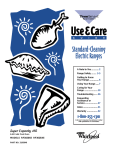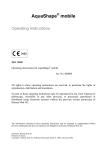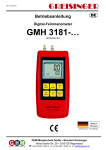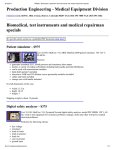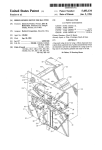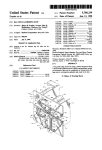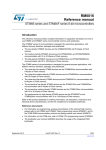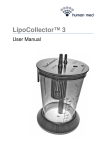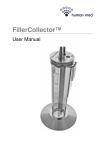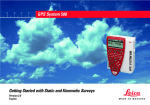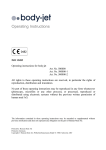Download body-jet® User Manual
Transcript
® body-jet User Manual Human Med AG User Manual body-jet® Cover sheet Doc-No.: 900018 Page: 1 Rev./ Date: 10/ 13-08-2013 WITH RESPECT TO ELECTRICAL SHOCK, FIRE AND MECHANICAL HAZARDS ONLY IN ACCORDANCE WITH UL 60601-1:2003 R6.03 AND CAN/CSA C22.2 No. 601.1 Caution: Federal law (USA) restricts this device to sale by or on the order of a physician. ISO 13485 under CMDCAS User Manual for body-jet® Art. No. 500000-1 All rights to these operating instructions are reserved, in particular the rights of reproduction, distribution and translation. No part of these operating instructions must be reproduced in any form whatsoever (photocopy, microfilm or any other process), or processed, reproduced or distributed using electronic systems without the previous written permission of Human Med. The information contained in these operating instructions may be amended or supplemented without previous notification and does not represent any obligation on the part of Human Med. Printed by Human Med AG Printed in Germany Copyright © Human Med AG; Wilhelm-Hennemann-Straße 9, 19061 Schwerin, Germany; 2013 Human Med AG User Manual body-jet® Cover sheet Doc-No.: 900018 Page: 2 Rev./ Date: 10/ 13-08-2013 Human Med AG Doc-No.: 900018 User manual for body-jet® Page: 1 Table of contents Rev./ Date: 09/21.05.2012 Table of contents I. Description of the body-jet® 1-2.1 II. Safety information and measures 1-2.2 II. 1. Intended use 1-2.2 II. 2. Contraindications 1-2.2 II. 3. Safety notations 1-2.2 II. 4. Warnings 1-2.2 II. 5. Precautions 1-2.3 II. 6. Compliance with safety information 1-2.3 II. 7. Safety of equipment and instruments 1-2.3 II. 8. Contribution of medical staff to safety 1-2.3 II. 9. Significance of the user manual and training of medical staff 1-2.4 II.10. Electrical safety and electromagnetic compatibility 1-2.4 II. 10. 1. 1-2.5 II.11. III. IV. Prevention of electric shock Particular safety instructions for use of the body-jet® 1-2.6 Control elements and symbols 3.1 III. 1. Control elements of the membrane keypad 3.1 III. 2. Control elements on the front and on both sides of the device 3.2 III. 3. Control elements on the rear side of the device 3.4 III. 4. Type label 3.5 III. 5. Other symbols 3.6 WAL Applicator and WAL cannulae 4.1 IV. 1. Description of the sterile single-use WAL Applicator (Applied part of BF type) 4.1 IV. 2. Description of the reusable WAL cannulae 4.2 IV. 3. Reprocessing of the reusable WAL cannulae 4.2 Human Med AG Doc-No.: 900018 User manual for body-jet® Page: 2 Table of contents V. VI. Rev./ Date: 09/21.05.2012 Installation of the body-jet® 5.1 V. 1. Ambient conditions 5.1 V. 1. 1. No operation in explosion hazard zones 5.1 V. 1. 2. Operating conditions 5.1 V. 1. 3. Ventilation 5.1 V. 1. 4. Exposure to liquids 5.1 V. 1. 5. Power cord and power socket 5.1 V. 1. 6. Installation of the body-jet® 5.2 V. 2. Components / device combination 5.2 V. 3. Preparations for use 5.3 V. 3. 1. Visual inspection 5.3 V. 3. 2. Connection of the body-jet® 5.3 V. 3. 3. Device test after switch-on 5.4 V. 3. 4. Test of the weighing system 5.5 V. 3. 5. Test of the vacuum build-up 5.6 V. 3. 6. Test of the flow generation unit 5.6 Working with the body-jet® 6.1 VI. 1. Installation of the infiltration pump 6.1 VI. 2. Insertion of the suction bag and connection of the suction tube 6.2 VI. 2. 1. Connection of the suction containers 6.2 VI. 2. 2. Insertion of the suction bag 6.3 VI. 2. 3. Connection of the WAL Applicator to the second suction bag 6.5 VI. 2. 4. Removal and replacement of the suction bag 6.6 VI. 2. 5. Disposal of the filled suction bags 6.6 VI. 3. Connection of the WAL Applicator to the liquid bags 6.7 VI. 4. Venting of the WAL Applicator and attachment of the WAL cannula 6.8 Human Med AG Doc-No.: 900018 User manual for body-jet® Page: 3 Table of contents VI. 5. Rev./ Date: 09/21.05.2012 Startup of the flow generation and the suction unit 6.10 VI. 5. 1. Test of the suction unit 6.10 VI. 5. 2. Test of the overflow protection/ bacterial filter 6.10 VI. 5. 3. Preparation of the device for surgical intervention 6.11 VI. 6. Operation 6.12 VI. 7. End of operation 6.13 VII. Cleaning, disinfection and storage after operation VII. 1. Before cleaning and disinfection 7.1 VII. 2. Cleaning and disinfection 7.1 VII. 3. After cleaning and disinfection 7.2 VIII. Troubleshooting IX. X. 7.1 8.1 VIII. 1. Localization and elimination of causes for functional and operating faults 8.1 VIII. 2. Error messages and audible signals 8.4 Maintenance, warranty, disposal and customer service 9.1 IX. 1. Maintenance 9.1 IX. 1. 1. Authorized persons 9.1 IX. 1. 2. Safety inspections 9.1 IX. 1. 3. Modifications and changes of components 9.2 IX. 1. 4. Periodic maintenance 9.2 IX. 2. Warranty 9.2 IX. 3. Disposal 9.2 IX. 4. Customer service 9.3 Technical description of the body-jet® 10.1 X. 1. Technical data 10.1 X. 2. Ambient conditions for transport and storage during transportation 10.2 X. 3. Ambient conditions for operation and storage at the customer’s 10.2 Human Med AG Doc-No.: 900018 User manual for body-jet® Table of contents XI. Page: 4 Rev./ Date: 09/21.05.2012 Storage and transportation of the body-jet® 11.1 XI. 1. Transportation over a threshold 11.2 XI. 2. Transportation in lying position 11.3 APPENDIX Current product list Human Med AG Doc-No.: 900018 User manual for body-jet® Chapter I and II Page: 1-2.0 Rev./ Date: 09/21.05.2012 Content I. Description of the body-jet® 1 II. Safety information and measures 2 II. 1. Indications for use 2 II. 2. Contraindications 2 II. 3. Safety notations 2 II. 4. Warnings 2 II. 5. Precautions 3 II. 6. Compliance with safety information 3 II. 7. Safety of equipment and instruments 3 II. 8. Contribution of medical staff to safety 3 II. 9. Significance of the user manual and training of medical staff 4 II. 10. Electrical safety and electromagnetic compatibility 4 II. 10. 1. Prevention of electrical shock II. 11. Particular safety instructions for use of the body-jet® 5 6 Human Med AG User manual for body-jet® Chapter I and II Doc-No.: 900018 Page: 1-2.1 Rev./ Date: 09/21.05.2012 I. Description of the body-jet® Water-assisted lipoplasty (WAL) with the body-jet® In the water-assisted lipoplasty method with the body-jet® a gentle pulsating fanshaped spray is used to apply saline during lipoplasty. The water spray is introduced into adipose tissue to loosen the tissue structure and to release adipocytes. During WAL with the body-jet®, a flow generation system pipes the infiltration solution (saline) through a sterile, closed tubing system into an infiltration cannula or irrigation/ aspiration cannula that can vary in diameter and arrangement of openings (similar to other liposuction cannulae). The settings for the flow generation can be adjusted in five levels (RANGE 1, 2, 3, 4 and 5). The body-jet® consists of a powered vacuum pump with a double piston, a vacuum gauge for adjusting the vacuum pressure, a safety trap, an overflow protection/ bacterial filter in the tube between the vacuum pump and the suction bag, suction bags with integrated overflow protection/ bacterial filters, two suction containers, a connecting tube and infiltration and irrigation/ aspiration cannulae. The bacterial filters, tubing, suction bags, and cannulae are to be changed for each patient. The body-jet® must be used together with a sterile, single-use tubing set with a small infiltration pump (WAL Applicator) transporting the saline for the infiltration into the tissue area, and a vacuum pump transporting the aspirate from the cannula into the suction containers. The WAL Applicator is classified as an applied part of BF type. A gentle pulsating fan-shaped saline spray is introduced into the adipose tissue through the WAL Applicator and the infiltration or irrigation/aspiration cannulae in order to infiltrate and to loosen and separate the fat cells. Saline solution for loosening adipose tissue and for intralobular and intracellular infiltration can be applied continuously during the whole aspiration process. The irrigation/ aspiration cannulae are used for the aspiration of the loosened fat cells and the continuous infiltration of saline fluid. Human Med AG Doc-No.: 900018 User manual for body-jet® Chapter I and II Page: 1-2.2 Rev./ Date: 09/21.05.2012 II. Safety information and measures II. 1. Indications for use The body-jet® is indicated for aesthetic body contouring. The body-jet® must only be used together with a WAL Applicator system and WAL cannulae produced by Human Med. The WAL applicator is classified as an applied part of BF type. II. 2. Contraindications The body-jet® and the instruments to be connected are not approved for intra-cardiac application. The body-jet® should not be used in patients with severe coagulation disorders. II. 3. Safety notations The WARNING! safety symbol refers to a risk of personal injury. The CAUTION! safety symbol refers to a risk of material damage. The ATTENTION! safety symbol refers to a risk that may cause equipment to become unserviceable. Please pay particular attention to the safety instructions in each chapter. II. 4. Warnings 1. This device will not, in and of itself, produce significant weight reduction. 2. This device should be used with extreme caution in patients with chronic medical conditions, such as diabetes, coagulation disorders, heart or lung disease, circulatory diseases, or obesity. 3. The volume of blood loss and endogenous body fluid may adversely affect intra and/or postoperative hemodynamic stability and patient safety. 4. The capability of providing adequate, timely fluid replacement is essential for patient safety. Human Med AG User manual for body-jet® Chapter I and II Doc-No.: 900018 Page: 1-2.3 Rev./ Date: 09/21.05.2012 II. 5. Precautions 1. This device is designed to contour the body by removing localized deposits of excess fat through small incisions in male and female adults. 2. Safety and effectiveness in pregnant woman and children have not been established. 3. Use of this device is limited to those physicians who, by means of residency training or sanctioned continuing medical education, have demonstrated proficiency in suction lipoplasty. 4. Results of this procedure will vary depending upon patient age, surgical site, and experience of the surgeon. 5. Results of this procedure may or may not be permanent. 6. The amount of fat removed should be limited to that necessary to achieve the desired cosmetic effect. 7. All reusable components of the device must be sterilized and all disposable components replaced before using the device on another patient. 8. If the vacuum regulator does not regulate the vacuum pressure properly, or if the suction cannula and tip are not of appropriate size, shape and rigidity, this might result in tissue damage. II. 6. Compliance with safety information Appropriate application of and compliance with the safety information considerably contributes to the safety of the user, of the patients and the environment. II. 7. Safety of equipment and instruments The body-jet® complies with all relevant and generally accepted engineering practices as well as with the applicable occupational protection and accident prevention regulations. II. 8. Contribution of medical staff to safety Working with medical equipment is basically associated with certain risks to medical staff and patients. Risks cannot be entirely eliminated by design features alone. Safety does not depend solely on the equipment but to a large extent on factors influenced by its user. These factors are dealt with in the safety information of this chapter. Human Med AG Doc-No.: 900018 User manual for body-jet® Chapter I and II Page: 1-2.4 Rev./ Date: 09/21.05.2012 II. 9. Significance of the user manual and training of medical staff Who should read this user manual? The user manual represents an important part of the product safety concept. Therefore, everyone who is concerned with preparation, setup, operation, disassembly, cleaning and disinfection of the device (including accessories) must read the user manual and the instructions for use of the instruments. This user manual is an inherent part of the body-jet®. All users must be familiar with the instructions included herein. Keep these instructions in the manual. Keep this manual in a safe but easily accessible place so that all users may consult it at any time. Before using the device, each user must acquaint himself with the appropriate flowrate settings for each application in literature studies and/or trial tests. Training Only medical staff who has been properly trained in operation and handling of this equipment is allowed to use the body-jet® in strict adherence to the present user manual. The training is to be carried out only by personnel who are qualified on the basis of their knowledge and practical experience. Human Med assumes no liability for any damage resulting from using the device without proper training or improper use. In case of any uncertainty or question, please contact Human Med. We will be glad to give you further assistance and to receive your suggestions concerning this user manual. II. 10. Electrical safety and electromagnetic compatibility The device must be connected to an earthed mains supply in accordance with the applicable version of standard IEC 60601-1-2. The body-jet® has been tested for immunity to interference and for electromagnetic compatibility by an accredited laboratory. The test results are within the limit values for medical electrical equipment as defined in the applicable version of standard IEC 60601-1-2. That means that this device is adequately immune to interference and cannot interfere with other devices, provided that it has correctly been installed and works properly. Human Med AG Doc-No.: 900018 User manual for body-jet® Chapter I and II Page: 1-2.5 Rev./ Date: 09/21.05.2012 An exception to this is the interaction with HF surgical devices since these do not always comply with the limit values of the applicable version of standard IEC 60601-12. When using the body-jet® together with HF surgical appliances a safety distance of at least two meters must be maintained between the body-jet® and the HF surgical unit as well as the HF surgical cables. When using the body-jet® together with HF surgical appliances or laser cutting devices priority is to be given to the safety regulations related to these devices. II. 10. 1. Prevention of electrical shock Leakage current The device complies with the requirements of the applicable version of standard IEC 60601-1 related to devices of protection class I and devices with applied parts of type BF. Power cord and power socket To avoid risk of electrical shock, this equipment must only be connected to supply mains with protective earth. The supply voltage must be identical to the voltage stated on the type label on the rear side of the body-jet®. Connect the device to a properly installed and grounded outlet. Only use the power cord supplied with the device. Equipment check Check the device and its accessories (e.g. cords/ cables, footbellows) for damage prior to each use. Do not use a damaged device, a damaged instrument trolley or damaged accessories. Replace defective accessories. For spare parts or servicing please contact our customer service. For your own safety and that of your patients, never attempt to repair by yourself. Any modification to the equipment will exempt Human Med from liability. Human Med AG Doc-No.: 900018 User manual for body-jet® Chapter I and II Page: 1-2.6 Rev./ Date: 09/21.05.2012 II. 11. Particular safety instructions for use of the body-jet® The following instructions must be strictly observed: - Every person operating the device must previously be instructed and familiar with operational parameters. - The foot-bellows must not be operated before use of the device. - The infiltration line must not be kinked. - The WAL Applicator and the used WAL cannula must not be directed towards the eyes. When working with the device, the foot-bellows have to be secured against unintentional actuation. When attaching the hand piece, take care that the water jet is only directed towards the operating field. Operational safety The use of this device is limited to those physicians who, by means of residency training or sanctioned continuing medical education, have demonstrated proficiency in suction lipoplasty. The device must be installed and initially put into operation only by qualified staff who has been trained by Human Med or their authorized representatives. The device may only be used after: - delivery and installation of the device by the service team of Human Med or their authorized representatives; - implementing all safety measures as described in this user manual; - mastering functional procedures and operation of the device in case of a malfunction. Every person operating the device is fully responsible for implementing all safety measures required to ensure that the patient, the surgeon and all other attendees are not exposed to danger during operation of the device. Before using the device, each user must acquaint himself with the appropriate flow-rate settings for each application in literature studies and/or trial tests. Safety features Safe and reliable operation of the body-jet® is ensured by a series of built-in safety features: - The flow build-up is only possible after an audible click indicating that the infiltration pump has been inserted correctly. - The device has been designed in a way that gross operational errors are excluded. - The design of the disposable WAL Applicator doesn’t allow its resterilization. Human Med AG User manual for body-jet® Chapter I and II Doc-No.: 900018 Page: 1-2.7 Rev./ Date: 09/21.05.2012 - The liquid flow will be stopped by a non-return valve in case the foot-bellows is not actuated. Human Med AG User manual for body-jet® Chapter III Doc-No.: 900018 Page: 3.0 Rev./ Date: 10/13-08-2013 Content III. Control elements and symbols 1 III. 1. Control elements of the membrane keypad 1 III. 2. Control elements on the front and on both sides of the device 2 III. 3. Control elements on the rear side of the device 4 III. 4. Type label 5 III. 5. Other symbols 6 Human Med AG Doc-No.: 900018 User manual for body-jet® Page: 3.1 Chapter III Rev./ Date: 10/13-08-2013 III. Control elements and symbols III. 1. Control elements of the membrane keypad (1) Vacuum gauge: shows the current vacuum (display accuracy: ± 25 mbar). Note: The numbers on the outer circle (0 to -1) are valid for a vacuum pressure in bar. The vacuum can be read in mmHg by means of the numbers on the inner circle (0 to 750). Fig. 1: Vacuum gauge (2) Display (top right): The total liquid consumption is indicated on this display. (3) Display (down right): The current liquid consumption is indicated on this display. (4) MEM: By pushing this key the weighing system is operated. (5) VACUUM ON/OFF: Using this key the suction unit is switched on or off. (6) STOP: In case of failures or emergencies this button is to be pressed to stop the device. (7) Display (on the left): After switching the body-jet® on the software version and then the current flow range (RANGE 1 to 5) are indicated on this display. (8) + and – : Using these keys the flow range can be changed over. (9) ON/OFF: By pressing this key the flow generation unit is switched over to stand-by or off. (10) EJECT PUMP: Using this key the infiltration pump is unlocked and can be pulled out from its socket (see chapter VI. 7. End of operation). Fig. 2: Membrane keypad Human Med AG Doc-No.: 900018 User manual for body-jet® Page: 3.2 Chapter III Rev./ Date: 10/13-08-2013 III. 2. Control elements on the front and on both sides of the device (11) Socket for the infiltration pump (12) Adjusting knob of the vacuum regulator: The vacuum is to be adjusted to the required level by turning this rotary knob. (13) Vacuum change-over switch: is turned to select the suction container to be used. (14) Suction bag with angle connector: is to be inserted into the suction container in order to collect the waste aspirate. (15) Suction container: is used to hold the suction bag. (16) Sealing cap: Is used to hold the infiltration pump in position and to close its socket. 11 Fig. 3: Socket for insertion of the infiltration pump 16 14 12 14 15 13 15 Fig. 4a: Front view 14 Fig. 4b: Suction bag This symbol indicates that the infiltration pump of the WAL Applicator must be inserted into the socket (11). The WAL Applicator is an applied part of BF type. Human Med AG Doc-No.: 900018 User manual for body-jet® Page: 3.3 Chapter III Rev./ Date: 10/13-08-2013 (17) Vacuum hose with overflow protection/ bacterial filter: is used together with two (2) elbow plug connectors for connecting the suction container to the suction unit of the body-jet®. (18) Suction port: is used to connect the plug connector of the vacuum hose with overflow protection/ bacterial filter to the suction unit. 16 1 16 17 6 17 18 18 14 15 Fig. 4c: Side view This symbol indicates that the user manual of the device must be read before components are connected to the suction port. (19) Overflow protection/ bacterial filter Never operate the body-jet® without using the overflow protection/ bacterial filter. 19 Fig. 5: Overflow protection/ bacterial filter This symbol signifies that the following number is the batch code of the product. This symbol indicates the maximum date until which the product may be used. Prior to any surgical intervention, the proper functioning of the overflow protection/ bacterial filter must be checked (see chapter VI. 5. 2. Test of the overflow protection/ bacterial filter). In case of improper function replace the overflow protection/ bacterial filter. Human Med AG Doc-No.: 900018 User manual for body-jet® Page: 3.4 Chapter III Rev./ Date: 10/13-08-2013 III. 3. Control elements on the rear side of the device (20) Weighing system: The current weight of the liquid bags is determined by means of the weighing system. (21) Hooks for attachment of the liquid bags (one bag to each hook) The maximum volume of the bags that can be held by the hooks is 6000 ml totally. (22) Before removing the rack, the connector (23) for the weighing system is to be screwed off. Fig. 6: Rear view (top) Ensure that the weighing system is pointing away from the membrane keypad when attaching the rack (see Fig. 14 on page 5.4). 24 23 (23) Connector for the weighing system: is used for connecting the control PCB and the weighing system (20) that registers the liquid consumption during surgical intervention. (24) Master switch: is actuated to power the body-jet® on/off. (25) Foot-bellows holder: Put the foot-bellows into the bracket holders for transport or after powering off the bodyjet®. (26) Foot-bellows connection port (28) Foot-bellows: The foot-bellows is actuated to activate the flow generation in the cannula. (29) Roller wheels with brakes Fig 6a Fig. 7: Rear view (down) Removable rack Human Med AG Doc-No.: 900018 User manual for body-jet® Page: 3.5 Chapter III Rev./ Date: 10/13-08-2013 (27) 27 Fig. 8: Power cord and plug Power connection/ Power cord: The body-jet® is equipped with a hard-wired power cord including power plug in order to electrically isolate all circuits of the body-jet® from the supply mains. Connect the body-jet® to a correctly installed and grounded socket outlet using only the original power cable or an equivalent power cable. The power cable must bear the national test symbol. To avoid damage and risk of electrical shock never pull the cord. Grab the plug when isolating the body-jet® from the supply mains. III. 4. Type label The type label is to be found on the rear side of the device. It shows the following symbols: Fig. 9: Type label This symbol signifies that the user manual and other relevant instructions must be read and followed. This symbol indicates that pushing at the sides of the device is prohibited. Human Med AG Doc-No.: 900018 User manual for body-jet® Page: 3.6 Chapter III Rev./ Date: 10/13-08-2013 This symbol is followed by the date of manufacture of the device. This symbol indicates that the product conforms to the specifications of TÜV Rheinland of North America (OSHA requirements) for the United States of America and Canada. This symbol signifies that the product is in conformity to the specifications of the Council Directive 93/42/EEC for medical products; and the manufacturer works with a quality assurance system monitored by the Notified Body no. 0482. This symbol signifies that the device, at the end of its service life, shall not be disposed of in the domestic waste (as to the correct disposal see chapter IX). III. 5. Other symbols Fig. 10: Hooks for attachment of the liquid bags Symbol for handling of the device during transport The device must not be transported outside the OP area with liquid bags attached. While transporting the device, there is the risk to bump against the weighing system. Fig. 11: Foot-bellows connection ports on the rear side of the device Human Med AG Doc-No.: 900018 User manual for body-jet® Page: 3.7 Chapter III Rev./ Date: 10/13-08-2013 Symbol for foot-bellows connection This symbol signifies that solely a foot-bellows is to be connected to the port labelled with this symbol. Only use and connect the air pressure foot-bellows supplied by Human Med together with the device. Note: There are two different types of foot-bellows included in the scope of supply: one pair of one-sided foot-bellows (manufactured by Herga Electric Ltd., item no. 6448-AAAC-0000; see Fig 12) and another pair of double-sided foot-bellows (manufactured by Herga Electric Ltd., item no. 6448-EAAC-0000; see Fig. 13). The inner diameter of the cable for the foot-bellows shall not be more than 3.2 mm. The outer diameter of the cable must not exceed 6.4 mm. Please use that type of foot-bellows that you consider to be most convenient to operate. Fig. 12: one-sided foot-bellows Fig. 13: double-sided foot-bellows Human Med AG Doc-No.: 900018 User manual for body-jet® Chapter IV Page: 4.0 Rev./ Date: 09/21.05.2012 Content IV. WAL Applicator and WAL cannulae 1 IV. 1. Description of the sterile single-use WAL Applicator (Applied part of BF type) 1 IV. 2. Description of the reusable WAL cannulae 2 IV. 3. Reprocessing of the reusable WAL cannulae 2 Human Med AG Doc-No.: 900018 User manual for body-jet® Page: 4.1 Chapter IV Rev./ Date: 09/21.05.2012 IV. WAL Applicator and WAL cannulae IV. 1. Description of the sterile single-use WAL Applicator (Applied part of BF type) A E F C B H G D Fig. 14: WAL Applicator system (A) Hand-piece with jet capillary tube: Is used to introduce the irrigation fluid into the body area concerned and to transport adipose tissue. (B) Pricking pin with protection cap: Is used to connect the transfer tubing set with the liquid bags. (C) Tube clamp of the transfer tubing set: By closing the tube clamp the fluid supply into the WAL applicator system can be interrupted if required. (D) Transfer tubing with two transfer tubes: Is used to connect two liquid bags at the same time. (E) Tube socket: By means of this socket the suction tube (F) is attached to the suction bag. (F) Suction tube with socket (E): Is used to connect the hand-piece (A) with the suction bag. (G) Infiltration pump with a piston: Is used to produce the set flow for detachment of the fat cells. (H) PA tubing: Is used for transporting the pressurized fluid to the jet capillary from the infiltration pump (G) to the hand-piece (A). Human Med AG Doc-No.: 900018 User manual for body-jet® Page: 4.2 Chapter IV Rev./ Date: 09/21.05.2012 IV. 2. Description of the reusable WAL cannulae The WAL cannulae are delivered unsterile and must be thoroughly cleaned and sterilized before use according to the processing instructions. At the beginning of the liposuction an infiltration cannula is used for fluid infiltration. The infiltration cannula has only one hole through which the physiological saline is infused into the adipose tissue. Irrigation/ aspiration cannulae have several suction holes and one bypass hole in their hand-piece for starting and stopping the suctioning by either closing or opening the hole. (I) Irrigation and aspiration cannula: is available in various designs (see current product list). (K) Bypass hole: By closing and opening the bypass-hole the suctioning is started and stopped. Fig. 15: WAL irrigation and aspiration cannula IV. 3. Reprocessing of the reusable WAL cannulae The infiltration and irrigation/ aspiration cannulae are supplied unsterile. They must be thoroughly cleaned and sterilized before every occasion of use. Detailed instructions on cleansing, disinfection, and sterilization of the infiltration and irrigation/ aspiration cannulae are outlined in the “Reprocessing instructions for WAL cannulae” (as package insert attached to each cannulae delivery). These instructions have been validated by the manufacturer as being suitable for the preparation of the infiltration and irrigation/ aspiration cannulae for reuse. The person responsible for cleansing is obliged to ensure that the cleansing actually carried out with the equipment, materials and staff deployed in the cleansing facility attains the desired results. As a guarantee of the latter, validation and routine monitoring of the procedure are normally necessary. It is equally important that any departure from the instructions provided must be carefully evaluated by the person responsible for cleansing with regard to their effectiveness and possible disadvantageous consequences. Human Med AG User manual for body-jet® Chapter IV Doc-No.: 900018 Page: 4.3 Rev./ Date: 09/21.05.2012 Human Med AG Doc-No.: 900018 User manual for body-jet® Page: 5.0 Chapter V Rev./ Date: 09/21.05.2012 Content V. Installation of the body-jet® 1 V. 1. Ambient conditions 1 V. 1. 1. No operation in explosion hazard zones 1 V. 1. 2. Operating conditions 1 V. 1. 3. Ventilation 1 V. 1. 4. Exposure to liquids 1 V. 1. 5. Power cord and power socket V. 1. 6. Installation of the body-jet ® 1 2 V. 2. Components / device combination 2 V. 3. Preparations for use 3 V. 3. 1. Visual inspection V. 3. 2. Connection of the body-jet 3 ® 3 V. 3. 3. Device test after switch-on 4 V. 3. 4. Test of the weighing system 5 V. 3. 5. Test of the vacuum build-up 6 V. 3. 6. Test of the flow generation unit 6 Human Med AG Doc-No.: 900018 User manual for body-jet® Chapter V Page: 5.1 Rev./ Date: 09/21.05.2012 V. Installation of the body-jet® V. 1. Ambient conditions V. 1. 1. No operation in explosion hazard zones Only use the equipment in rooms used for medical purposes. Do not operate the device in explosion hazard zones in which flammable anaesthetics, combustible skin cleaners or disinfectants are used. V. 1. 2. Operating conditions Only operate the equipment at temperatures and air humidity conditions as specified in chapter X. Technical description of the body-jet®. Exceeding the indicated tolerances may lead to breakdown of the installed equipment. When operating the device at an ambient temperature of more than 35 °C, do not touch the device surfaces for longer than 10 sec.. V. 1. 3. Ventilation The equipment must be placed in a way ensuring that air can freely circulate around the system housing. The installation in narrow alcoves is not allowed. V. 1. 4. Exposure to liquids The equipment housing is not entirely water-tight. Therefore, be careful not to spill liquids around or on the equipment. Do not install the device in direct proximity of hoses or bins containing liquid. V. 1. 5. Power cord and power socket The supply voltage must be identical to the voltage indicated on the type label on the rear side of the body-jet®. Connect the device to a grounded outlet. Only use the Human Med power cord supplied with the device. For safety reasons do not use any extension leads or power distribution units. Human Med AG Doc-No.: 900018 User manual for body-jet® Chapter V Page: 5.2 Rev./ Date: 09/21.05.2012 Run the power cord from the device to the outlet in a way that hazardous situations (e.g. tripping) are eliminated. Do not connect the device to the power supply neither use it, if it is in defective conditions that cannot be properly remedied in a professional manner. V. 1. 6. Installation of the body-jet® Place the body-jet® on a stable, horizontal, and vibration-free surface to ensure its stability. For thermal reasons and adequate display legibility the device must not be exposed to direct sunlight. The rear side of the body-jet® must be directed away from the operating field. Always keep a safety distance of at least 1 m between the device and the sterile areas, particularly the tables for instruments, operating tables and staff wearing sterile garment. Apply the brakes of all four roller wheels when placing the device. V. 2. Components / device combination Only use components together with the body-jet® that are specified by Human Med in this user manual. This particularly applies to the following parts: Foot-bellows with suitable cables (produced by Herga Electric Ltd., item no. of the one-sided foot-bellows 6448-AAAC-0000; item no. of the double-sided foot-bellows 6448-EAAC-0000), 3000 ml suction container (waste) (produced by Serres Oy, item no. 57348), 3000 ml suction bag (produced by Serres Oy, item no. 57187), Hydrophobic filter set (incl. vacuum hose with overflow protection/ bacterial filter (produced by Medela AG, item no. 077.0572), elbow plug connectors to connect the suction container to the suction port of the device), Sealing cap of the infiltration pump socket The body-jet® must only be operated using disposable WAL Applicators and reusable WAL cannulae produced by Human Med. The current product list is applicable. Human Med AG Doc-No.: 900018 User manual for body-jet® Chapter V Page: 5.3 Rev./ Date: 09/21.05.2012 Any modification to the body-jet® device, the WAL Applicator, the WAL cannulae or other accessories are not allowed and will result in exemption of Human Med from liability. The suction tube of the WAL Applicator is allowed to be connected to any other appropriate suction device. Other combinations of equipment are not allowed and will result in exemption of Human Med from liability. The body-jet® must only be operated using liquid bags with sterile 0.9% normal saline according to United States Pharmacopeia, with a maximum volume of 3 liter per bag. V. 3. Preparations for use After properly installing the body-jet® according to this user manual and before using the device, a trial operation of all important functions must be performed. V. 3. 1. Visual inspection Thoroughly check the device and its components (e.g. including removable parts such as cords/ cables and foot-bellows) for damage before use. Do not use a damaged device or damaged components. Check the guarantee seal between the housing cover and the device housing and the type label on the rear side of the device. The device must not be used, when the labels are damaged. V. 3. 2. Connection of the body-jet® Connect the device to a properly installed grounded outlet (see also chapter V. 1. 5. Power cord and power socket). Connect the foot-bellows to the ports (Number 26 in Fig. 7 on page 3.4, see also Fig. 11 on page 3.6). Attach the rack with the weighing system to the body-jet®. Human Med AG Doc-No.: 900018 User manual for body-jet® Page: 5.4 Chapter V Rev./ Date: 09/21.05.2012 Ensure that the weighing system is pointing away from the membrane keypad when attaching the rack (see Fig. 16). Fig. 16: Correctly attached rack Plug the connector of the weighing system in the respective socket (Number 23 in Fig. 6 on page 3.4). Install the suction containers with the connecting tubing and the overflow protection/ bacterial filter on the right and on the left side of the device. V. 3. 3. Device test after switch-on The master switch is located on the rear side of the device (Number 24 in Fig. 6 on page 3.4). The device is turned on by switching it to “I”. By switching it to “0” the device is turned off. ® Switch body-jetswitch on. The operating noise ofnoise the power unit canunit becan heard. Switch the the master to “I”. The operating of the supply power supply be heard. The display on the left indicates the current software version for approx. three seconds and then the current flow range (RANGE 1). There will be no indication on the right display first, but after three seconds the lower display field on the right shows “-------” (see Fig. 17). Fig. 17: Initial readout on the display Human Med AG Doc-No.: 900018 User manual for body-jet® Page: 5.5 Chapter V Rev./ Date: 09/21.05.2012 V. 3. 4. Test of the weighing system Attach a balance weight of max. 6 kg (in this example, a 3 kg weight) on the hooks. After quickly pressing the MEM key, the display on the right indicates the following information: The upper display field shows “0000 ml” and the lower display field shows “0000 ml” (see Fig 18). Fig. 18: Calibrated state Remove the balance weight from the hooks. In the lower display field appears the information “3000 ml” (± 100 ml) and the upper display field shows “0000 ml” (see Fig. 19). Fig. 19: Current meas. value Quickly push the MEM key again and the right display shows following information: “3000 ml” (± 100 ml) is indicated in the upper display field and “0000 ml” in the lower display field (see Fig. 20). Fig. 20: Total meas. value Human Med AG Doc-No.: 900018 User manual for body-jet® Page: 5.6 Chapter V Rev./ Date: 09/21.05.2012 Keep the MEM button pressed for three seconds to reset the liquid consumption values to zero (see Fig. 16). V. 3. 5. Test of the vacuum build-up Start the vacuum build-up by pushing the key VACUUM ON/OFF (Number 5 in Fig. 2 on page 3.1). The operating noise of the vacuum pump is to be heard. In order to adjust the maximum vacuum, turn the adjusting knob of the vacuum regulator (Number 12 in Fig. 3 on page 3.2) clockwise up to the stop. Turn the vacuum change over switch (Number 13 in Fig. 3 on page 3.2) to the top center in order to close the vacuum outlet. The vacuum gauge (Number 1 in Fig. 1 on page 3.1) now indicates a vacuum of 656 mmHg/ -0.9 bar (± 19 mmHg/ ± 0.02). Turn the vacuum change-over switch to the right or to the left in order to open the vacuum outlet. The vacuum gauge indicates a vacuum of at most 225 mmHg/ -0.3 bar. Turn the adjusting knob of the vacuum regulator counterclockwise up to the stop in order to adjust the minimum vacuum. The vacuum gauge indicates a vacuum of approx. 0 mmHg/ 0 bar. V. 3. 6. Test of the flow generation unit Switch the linear drive unit to stand-by by pushing the ON/OFF key on the left keypad panel FLOW (see Fig. 21). The LED of this key starts blinking. When actuating the foot-bellows the LED lights continuously. Fig. 21 Human Med AG User manual for body-jet® Chapter V Doc-No.: 900018 Page: 5.7 Rev./ Date: 09/21.05.2012 Look into the socket of the infiltration pump for checking whether the linear drive unit is moving (see Fig. 22). The moving speed of the linear drive unit decelerates or accelerates by pushing the keys “–” and “+”. The respective range “1----” to “----5” is indicated in the lower display field on the left side. Fig. 22: Pressure container socket Human Med AG Doc-No.: 900018 User manual for body-jet® Chapter VI Page: 6.0 Rev./ Date: 09/21.05.2012 Content VI. Working with the body-jet® 1 VI. 1. Installation of the infiltration pump 1 VI. 2. Insertion of the suction bag and connection of the suction tube 2 VI. 2. 1. Connection of the suction containers 2 VI. 2. 2. Insertion of the suction bag 3 VI. 2. 3. Connection of the WAL Applicator to the second suction bag 5 VI. 2. 4. Removal and replacement of the suction bag 6 VI. 2. 5. Disposal of the filled suction bags 6 VI. 3. Connection of the WAL Applicator to the liquid bags 7 VI. 4. Venting of the WAL Applicator and attachment of the WAL cannula 8 VI. 5. Startup of the flow generation and the suction unit 10 VI. 5. 1. Test of the suction unit 10 VI. 5. 2. Test of the overflow protection/ bacterial filter 10 VI. 5. 3. Preparation of the device for surgical intervention 11 VI. 6. Operation 12 VI. 7. End of operation 13 Human Med AG Doc-No.: 900018 User manual for body-jet® Page: 6.1 Chapter VI Rev./ Date: 09/21.05.2012 VI. Working with the body-jet® Before starting work with the body-jet®, the device must be installed properly. Instructions on installation are to be found in chapter V. Installation of the body-jet® of this user manual. The body-jet® must be connected to the power supply using the power cord supplied with the device and is to be powered on by pushing the master switch on the rear side. When switching the device on, the display on the left indicates the current software version for approx. three seconds and then the current flow range (RANGE 1). When switching the device on, no LED must emit light and no error message must be shown on the display. VI. 1. Installation of the infiltration pump Take the WAL Applicator from the sterile package. Only use WAL Applicators from undamaged packages! Remove the sealing cap from the socket of the infiltration pump by turning it counterclockwise. Push the infiltration pump into the socket. Fig. 23: Insert the infiltration pump 1 The infiltration tube (1) of the WAL Applicator must point upwards whereas the transfer tubes (2) must point downwards. 2 Fig. 24: Inserted infiltration pump The infiltration pump is pushed into place by applying slight pressure with the ball of the thumb (see Fig. 25). Fig. 25: Unlock the infiltration pump Human Med AG Doc-No.: 900018 User manual for body-jet® Page: 6.2 Chapter VI Rev./ Date: 09/21.05.2012 It is snapped into place by asserting little more pressure with the thumb itself (see Fig. 26). Note: If the infiltration pump is not correctly inserted and snapped into place, no flow can be generated! Fig. 26 Now fix the sealing cap hand-tight by slightly turning it clockwise. Fig. 27: Attach the sealing cap Fig. 27a: Turn the sealing cap clockwise. Fig. 28: Fixed sealing cap VI. 2. Insertion of the suction bag and connection of the suction tube VI. 2. 1. Connection of the suction containers Two suction containers of identical design are provided on the left and right side of the body-jet® for holding the single-use suction bags. The suction bags include a bacterial filter in the lid. Prior to use, always check the suction containers for cracks and other damages. Do not use damaged containers! Fig. 29 (A) Suction container (B) Lid of the suction bag (C) Port for angle connector (K) (L) Sealing plug Human Med AG Doc-No.: 900018 User manual for body-jet® Page: 6.3 Chapter VI Rev./ Date: 09/21.05.2012 (D) Vacuum hose with overflow protection/ bacterial filter (E) / (F) Elbow plug connectors (G) Suction port (K) Angle connector Fig. 30 Each suction container (A) is to be connected to the suction port (G) on the respective side of the device by means of a vacuum hose with overflow protection/ bacterial filter (D) and elbow plug connectors (E and F) on both ends. The vacuum hose with overflow protection/ bacterial filter and elbow plug connectors is included in the scope of supply. Note: The suction containers are exclusively intended for use with suction bags. Proper suctioning of the body-jet® can only be guaranteed if 3000 ml suction bags with angle connectors (produced by Serres Oy, item no. 57187) are used. Never connect the suction tube of the WAL Applicator to the suction port (G)! The connection port for the suction tube of the WAL Applicator is labeled with “PATIENT”. Never operate the body-jet® without the overflow protection/ bacterial filter! VI. 2. 2. Insertion of the suction bag Each suction container should hold a suction bag. When introducing the suction bag into the suction container proceed as follows: (1) Unfold the suction bag and introduce it into the suction container (see Fig. 31 and 32 on next page). Human Med AG Doc-No.: 900018 User manual for body-jet® Page: 6.4 Chapter VI Rev./ Date: 09/21.05.2012 Fig. 31: Unfold the suction bag (2) Fig. 32: Introduce the suction bag Switch the vacuum pump on by pushing the Vacuum ON/OFF key. (3) Turn the vacuum change-over switch (13) towards the currently used suction container (see Fig. 33). Fig. 33: Vacuum change-over switch (4) Introduce the lid of the suction bag under vacuum pressure; close the angle connector (K) with your finger and slightly press on the center point of the suction bag’s lid (see Fig. 34). The lid of the suction bag must seat air-tight and flush in the suction container. K Fig. 34 (5) Make sure by closing the angle connector (K) of the suction bag (see Fig. 35) that the required vacuum has been built up and the bag is completely unfolded. Keep the angle connector (K) closed with your finger until the final vacuum has been reached. Fig. 35 Human Med AG Doc-No.: 900018 User manual for body-jet® Chapter VI Page: 6.5 Rev./ Date: 09/21.05.2012 (6) Still keeping the angle connector closed; adjust the vacuum by turning the rotary knob of the vacuum regulator until the required value is indicated (see Fig. 36). Fig. 36 (7) Push the suction tube (M) of the WAL Applicator onto the angle connector (K) of the suction bag (see Fig. 37). The suction system is now ready for use. K M Fig. 37 VI. 2. 3. Connection of the WAL Applicator to the second suction bag Each suction bag is equipped with an integrated overflow protection that interrupts the suction procedure as soon as the suction bag is full. The WAL Applicator, therefore, should be changed over to the suction bag in the second suction container in time. Proceed as follows: (1) Pull off the angle connector (K) together with the suction tube (M) from the port (C) of the (full) suction bag (see Fig. 38). K C M L N Fig. 38 Human Med AG Doc-No.: 900018 User manual for body-jet® Page: 6.6 Chapter VI Rev./ Date: 09/21.05.2012 (2) Close this port with the sealing plug (L, see Fig. 39). L C Fig. 39 (3) Now turn the vacuum change-over switch (Number 13 in Fig. 3 on page 3.2) towards the suction container with the empty suction bag inside. (4) Push the suction tube (M) of the WAL Applicator onto the angle connector (K) of the new suction bag (see Fig. 40). M K Fig. 40 VI. 2. 4. Removal and replacement of the suction bag In case both suction bags are filled during a surgical intervention, you have to replace one or both suction bags. For this, pull the suction tube (M) with angle connector (K) from the port (C) of the full suction bag (see Fig. 36 on the preceding page). Then close this port (C) with the sealing plug (L), as shown in Fig. 37 on the preceding page. Remove the suction bag from the container (A) holding it on the grip (N). Insert a new suction bag according to the procedure described in chapter VI. 2. 2. Insertion of the suction bag. VI. 2. 5. Disposal of the filled suction bags The liquid suctioned off may contain germs harmful to health. Human Med AG Doc-No.: 900018 User manual for body-jet® Page: 6.7 Chapter VI Rev./ Date: 09/21.05.2012 The filled suction bags including the liquid suctioned off must be disposed of in strict adherence to the legal hygiene regulations. The bags must be disposed of in safe containers for infectious waste labeled as hazardous waste. Details can be taken from the hygiene plan of the hospital concerned. VI. 3. Connection of the WAL Applicator to the liquid bags (1) The liquid bags must be hung on the hooks of the rack. The total weight must not exceed 6000 g! Note: In case liquid bottles or canisters are used, these must be vented properly. We recommend using liquid bags only. (2) The WAL Applicator is to be connected to the liquid bags over the transfer tubing. The transfer tubing must be vented before operation according to the following routine: The transfer tubing consists of two transfer tubes (A and B) with clamps, pricking pins and protection caps. Close one transfer tube (A) by means of the clamp, but before remove the protection cap from its pricking pin (see Fig. 41). Fig. 41 Remove the protection from the pricking pin of the second transfer tube (B) and prick it into the liquid bag to be used first, as shown in Fig. 42 (the clamp of this transfer tube is open). Fig. 42 Human Med AG Doc-No.: 900018 User manual for body-jet® Page: 6.8 Chapter VI Rev./ Date: 09/21.05.2012 Now open the tube clamp of the first transfer tube (A) in order to vent the tubing system. B As soon as the transfer tube (A) is completely filled with liquid, re-clamp it and put the protection cap on the pricking pin again (see Fig. 43). A Fig. 43 The transfer tube (A) may now be pricked into the second liquid bag, if available, but before remove the protection cap from the pricking pin. By opening and closing the tube clamps you select the liquid bag requested for surgical intervention. The transfer tube (A) may also be fixed onto the rack by means of a tube clamp. When infiltration solution (saline) is spilled onto the device or its components, wipe it off immediately and thoroughly with a soft cloth and warm water. VI. 4. Venting of the WAL Applicator and attachment of the WAL cannula Before the cannula is attached, the WAL Applicator must be vented as follows: (1) Power on the body-jet® by actuating the master switch on the rear side of the device. (2) Switch the flow generation to stand-by by pushing the ON/OFF button on the membrane keypad FLOW. The stand-by mode of the flow generation is confirmed by the blinking LED. (3) Set the flow range to RANGE 3. (4) Activate the flow generation by actuating the foot-bellows (the green LED will be lit). Now the applicator system is being vented, and after a few seconds, a straight pencil jet of fluid will be produced. If no pencil jet of fluid is produced, the WAL Applicator is defective and must be replaced. Take care to direct the water-jet into a suitable container when venting the applicator system. Never direct the water jet towards persons! The supplied cannulae are unsterile! They must be thoroughly cleaned and sterilized before use! Follow the reprocessing instructions for WAL cannulae provided with the cannulae. Human Med AG Doc-No.: 900018 User manual for body-jet® Page: 6.9 Chapter VI Rev./ Date: 09/21.05.2012 Before attaching the cannula to the hand-piece of the WAL Applicator, check to ensure that you are using the right cannula and that it is undamaged. Do not use damaged cannulae! Do not use a WAL cannula if the cannula tube is bent by more than 10°. Cannula tubes that are bent by more than 10° could break. Bent cannulae should not be re-straightened, as this could cause the cannula tube to break; all bent cannulae should be taken out of use. The venting procedure is to be repeated when replacing the WAL Applicator. Note: B A (5) Then attach the desired WAL cannula (A) to the hand-piece of the WAL Applicator (B) as shown in Fig. 44. The jet of fluid should now be flat and fan-shaped and should come out of the nozzle at an angle (see Fig. 45). Fig. 44 Recommendation: Treat the inside of the cannula handle (A) with surgical silicone spray before attaching the cannula to the hand-piece of the single-use WAL Applicator (B). Note: If the wrong cannula is used, as shown in Fig. 46, the test spray jet will not be fan-shaped. Fig. 45: Correct spray pattern Note: Fig. 46: Incorrect spray pattern The spray pattern is to be checked again when a new WAL cannula is attached. Fig. 43: Correct spray pattern Human Med AG Doc-No.: 900018 User manual for body-jet® Page: 6.10 Chapter VI Rev./ Date: 09/21.05.2012 VI. 5. Startup of the flow generation and the suction unit VI. 5. 1. Test of the suction unit Switch the suction unit on by pressing the key VACUUM ON/OFF. Turn the adjusting knob of the vacuum regulator (12) clockwise up to the stop. 12 Fig. 47 Close the angle connector (K) with your finger and wait until the vacuum has been built up (see Fig 48). Check whether the vacuum gauge indicates a value of at least -825 mbar (if not, see chapter VIII. Troubleshooting). K Fig. 48 VI. 5. 2. Test of the overflow protection/ bacterial filter Adjust the vacuum pressure to the maximum level. Disconnect the elbow plug connector (B). Check the value shown on the vacuum gauge; it must not exceed -300 mbar. B In case of exceedance replace the overflow protection/ bacterial filter (produced by Medela, item no. 077.0572, REF No. US101931) or the complete hydro-phobic filter set (REF no. US 101947, see product list). Fig. 49 Human Med AG Doc-No.: 900018 User manual for body-jet® Page: 6.11 Chapter VI Rev./ Date: 09/21.05.2012 VI. 5. 3. Preparation of the device for surgical intervention (1) Turn on the body-jet® by pressing the master switch on the rear side of the device. (2) Switch the flow generation unit to stand-by by pushing the ON/OFF key on the left keypad panel FLOW (see Fig 50). The green LED is blinking. Start the flow generation by actuating the footbellows. The green LED is lighting continuously. Fig. 50 (3) Select the flow range using the + and - keys (RANGE 1 to 5) (see Fig. 51). The set flow range is shown on the left display field. Fig. 51 (4) Switch the suction unit on/ off by pushing the VACUUM ON/OFF key (see Fig. 52). Fig. 52 Human Med AG Doc-No.: 900018 User manual for body-jet® Page: 6.12 Chapter VI Rev./ Date: 09/21.05.2012 (5) Set the requested vacuum in the range from 0 to -850 mbar by turning the adjusting knob of the vacuum regulator (1, see Fig. 53). Fig. 53 (6) The current vacuum is indicated on the vacuum gauge (see Fig. 54). The final vacuum depends on the pump type used and on the height of the position above sea level. Fig. 54 Fig. 54a: Vacuum at different heigths above sea level The body-jet® is ready now for surgical intervention. In emergencies or in case of failures the suction unit and the flow generation can be put out of operation by pressing the STOP key. After the body-jet® has been stopped by pressing the STOP key, it can only be put into operation again using the master switch on the rear side of the device. VI. 6. Operation After a prick incision the aspiration/ irrigation cannula is inserted into the adipose tissue through the skin opening. By operating one of the two foot-bellows the flow generation unit is started and the water spray necessary to detach the fat cells is generated. The required suctioning is done by opening and closing the bypass hole in the cannula handle. The amount of liquid consumed during operation is displayed down on the right keypad panel Volume (see Fig. 55). Fig. 55 Human Med AG User manual for body-jet® Chapter VI Doc-No.: 900018 Page: 6.13 Rev./ Date: 09/21.05.2012 In order to activate this display, the MEM key must be pressed before starting the operation (see Fig. 56). Fig. 56 If the liquid consumption shall be indicated again, the displayed values can be reset by one quick push on the MEM key. The previous liquid consumption is stored as memory value and indicated at the top of the display on the right keypad panel (see Fig. 57). Fig. 57 This procedure may be repeated as often as required. The total consumption is always shown at the top; the amount of liquid consumed during the current operation is always shown down on the display of the right keypad panel Volume. By pressing the MEM key for three seconds all displayed consumption values are reset to zero (see Fig. 58). The consumption values should be reset when liquid bags have to be replaced during operation. Fig. 58 VI. 7. End of operation (1) Switch the flow generation unit off by pushing the ON/OFF key of the left keypad panel Flow (see Fig. 59). Fig. 59 Human Med AG User manual for body-jet® Chapter VI Doc-No.: 900018 Page: 6.14 Rev./ Date: 09/21.05.2012 (2) Remove the sealing cap (see Fig. 60). Fig. 60 (3) Press the EJECT PUMP key (see Fig. 61). The unit will beep for five seconds, indicating that the infiltration pump can be removed. Fig. 61 (4) At the same time, the word “REMOVE” appears in the left display (see Fig. 6Fig. 62). Fig. 62 (5) Remove the infiltration pump from the socket while the unit is beeping (see Fig. 63). Fig. 63 Human Med AG User manual for body-jet® Chapter VI Doc-No.: 900018 Page: 6.15 Rev./ Date: 09/21.05.2012 Fig. 64 If you were unable to remove the infiltration pump on your first attempt, the unlocking operation can be repeated one (1) more time. If additional attempts are made, the unlocking mechanism will automatically be disabled to protect the system from overheating. The red LED on the EJECT PUMP key will be lit (see Fig. 6Fig. 64). The deactivation will be canceled, and the LED will go out after five (5) minutes if, in that period, the EJECT PUMP key has not been pressed and the device is switched on. (6) Clamp the transfer tubes. Cut the tubing system above the infiltration pump. (7) Remove the reusable WAL cannula from the hand-piece of the WAL Applicator and let it be reprocessed immediately. (8) Switch the body-jet® off! Cut the device from power supply (by pulling the power plug)! Human Med AG User manual for body-jet® Chapter VII Doc-No.: 900018 Page: 7.0 Rev./ Date: 09/21.05.2012 Content VII. Cleaning, disinfection and storage after operation 1 VII. 1. Before cleaning and disinfection 1 VII. 2. Cleaning and disinfection 1 VII. 3. After cleaning and disinfection 2 Human Med AG Doc-No.: 900018 User manual for body-jet® Chapter VII Page: 7.1 Rev./ Date: 09/21.05.2012 VII. Cleaning, disinfection and storage after operation VII. 1. Before cleaning and disinfection Make sure that the device has been cut from power supply before starting with cleaning and disinfection (by pulling the power plug). Dispose of the single-use WAL Applicator and the suction bag! The system may contain germs harmful to health. The used WAL Applicator and suction bags must be disposed of in strict adherence to the legal hygiene regulations. Used products must be disposed of in closed containers for infectious waste labeled as hazardous waste. Details can be taken from the hygiene plan of the hospital concerned. VII. 2. Cleaning and disinfection The body-jet® and the associated components must be thoroughly cleaned before reuse. Do not use cleaning agents containing solvents for cleaning and disinfection. The use of an EPA-registered hospital disinfectant with label claim of tuberculocidal activity is recommended. Human Med tested a disinfectant with quaternary ammonium compounds with alcohol and only alcohol-based disinfectants without aldehyde. Moisture must not penetrate the equipment. Let any liquid entered immediately drain off. The device is only to be used again when the liquid has evaporated completely. For cleaning and disinfection of the surfaces of the body-jet® and its accessories we recommend wiping them with disinfectant. Only use disinfectants that conform to the national standards. Dilute the disinfectant in a concentration as specified by the manufacturer. Human Med AG Doc-No.: 900018 User manual for body-jet® Chapter VII Page: 7.2 Rev./ Date: 09/21.05.2012 Clean blood-contaminated surfaces with warm water before using the disinfectant, otherwise it may be less effective. When infiltration solution (saline) is spilled onto the device or its components, wipe it off immediately and thoroughly with a soft cloth and warm water. Wipe the surfaces; make sure that they are treated all-over. Observe the contact time of the disinfectant specified by the manufacturer. body-jet® Wipe the device with a soft cloth soaked in disinfectant. Sealing cap of the infiltration pump socket Wipe the sealing cap of the infiltration pump socket with a soft cloth soaked in disinfectant. If necessary also use a soft brush soaked in disinfectant. Fix the sealing cap to the socket again. Foot-bellows, foot-bellows tubing and power cord Wipe the foot-bellows, the foot-bellows tubing and the power cord with a soft cloth soaked in disinfectant. Suction container The suction container can be cleaned and disinfected by hand. Optionally, it can be washed at a temperature of 85 °C (185 °F) in a washer-disinfector and sterilized at a temperature of 121°C (250 °F) and a hold-time of at least 15 minutes. Only use cleaners that are approved by the producer for cleaning PC plastics. Never use rinse agents, because they can cause stress cracks in the suction container and can shorten its service life. The suction container has been successfully tested for a thirty-time (30) reprocessing using the above described automated reprocessing procedures including sterilization. Further reprocessing beyond this number or other reprocessing procedures are in the user’s responsibility. Do not use cleaning agents and disinfectants containing phenol for manual or automated cleaning. Otherwise, the container can be damaged. Never use a damaged container; it can impede the vacuum build-up. VII. 3. After cleaning and disinfection (1) Hang the power cord and the foot-bellows in the bracket holders provided. (2) Park the body-jet® at the place provided for storage. The body-jet® may be transported in upright or lying position (see chapter XI. Storage and transportation of the body-jet®); but it has to be stored upright. Human Med AG Doc-No.: 900018 User manual for body-jet® Chapter VII Page: 7.3 Rev./ Date: 09/21.05.2012 (3) Apply the brakes to lock the wheels. (4) Thoroughly check the device and its components. Thoroughly check the device and its components (e.g. including removable parts such as cords/ cables and foot-bellows) for damage before and after each use. Do not use a damaged device or damaged components. Replace defective equipment. In case of damage to the device, please contact the responsible technical service. For your own safety and that of your patients, never attempt to repair by yourself. Any modification will exempt Human Med from liability. Human Med AG User manual for body-jet® Chapter VIII Doc-No.: 900018 Page: 8.0 Rev./ Date: 09/21.05.2012 Content VIII. Troubleshooting 1 VIII. 1. Localization and elimination of causes for functional and operating faults 1 VIII. 2. Error messages and audible signals 4 Human Med AG Doc-No.: 900018 User manual for body-jet® Chapter VIII Page: 8.1 Rev./ Date: 09/21.05.2012 VIII. Troubleshooting VIII. 1. Localization and elimination of causes for functional and operating faults The list below is provided to help users in localizing and, if possible, eliminating causes of functional faults, as well as to enable them to give more detailed information to the technical service of Human Med. No flow generation, no fluid comes out of the nozzle No / only weak suction with cannula Lack of vacuum Fault Possible cause of fault Instruction for elimination Incorrect vacuum pressure level Turn the vacuum adjusting knob to the required vacuum pressure level. The suction bag has not been inserted correctly, or the suction tube has not been attached correctly. Check the suction bag and the suction tube. Check the seals for cracks, perishing and leakage. The selected suction port (suction container) is not correct. Check which suction port has been selected. If necessary, rectify it using the vacuum change-over switch. The suction bag has not been inserted correctly, or the suction tube has not been attached correctly. Check the suction bag and the suction tube; correct if necessary. The aspiration cannula is blocked. Replace the aspiration cannula. Overflow protection/ bacterial filter of the tubing set and/or overflow protection of the suction bag is/ are blocked. Check the functioning of the overflow protection/ bacterial filter of the tubing set and/or overflow protection of the suction bag (in case of contact with liquids these parts block immediately and don’t let air pass anymore). Replace the overflow protection/ bacterial filter of the tubing set or the overflow protection of the suction bag. (1) The power plug has not been connected. Connect the power plug. (2) The master switch of the device is not “ON”. Press the master switch to power on the ® body-jet . (3) The foot-bellows have not been connected. Connect the foot-bellows. Human Med AG Doc-No.: 900018 User manual for body-jet® Page: 8.2 Chapter VIII Liquid underneath the device Weak water jet No flow generation, no fluid comes out of the nozzle Fault Rev./ Date: 09/21.05.2012 Possible cause of fault Instruction for elimination (4) The device has been correctly connected and switched on, but the display is blank. A fuse may have blown. Call technical service. (5) The “ON/OFF” key has not been pushed. Push the “ON/OFF” key. The small LED shall light green. (6) The foot-bellows actuated. Actuate the foot-bellows. has not been (7) The infiltration pump has not been correctly inserted into the socket. Repeat the installation routine described in chapter VI. 1. Installation of the infiltration pump of this user manual. (8) The sealing cap screwed properly. been Screw the sealing cap following the description in chapter VI. 1. Installation of the infiltration pump. The cap must not be removable without turning it slightly counterclockwise. (9) The liquid bag has not been connected. Prick the pricking pin of the transfer tubing into the liquid bag (see chapter VI. 3. Connection of the WAL Applicator to the liquid bags). (10) One clamp of the transfer tubing is not open. Check the clamps and open if necessary. Check the transfer tube leading to the liquid bag. (11) The transfer tubing set has not been vented properly. Check the connection routine for the WAL Applicator described in chapter VI. 4. Venting of the WAL Applicator and attachment of the WAL cannulae. (12) The WAL Applicator is blocked or faulty. The infiltration pump is broken. Other causes. Although all above mentioned items have been checked thoroughly, there is no liquid coming out of the WAL Applicator after actuating the foot-bellows for 60 sec. Replace the WAL Applicator. The WAL Applicator is blocked or faulty. Replace the WAL Applicator. The WAL Applicator is blocked or faulty. Replace the WAL Applicator. has not Human Med AG Doc-No.: 900018 User manual for body-jet® Chapter VIII The infiltration pump of the WAL Applicator cannot be removed. Fault Page: 8.3 Rev./ Date: 09/21.05.2012 Possible cause of fault Instruction for elimination (1) The flow generation has not been deactivated (by pushing the “ON/OFF” key). Push the “ON/OFF” key to deactivate the flow generation. (2) The infiltration pump was not removed within the time period indicated by the audible signal. Push the “EJECT PUMP” key and remove the infiltration pump from the socket within five seconds (the period during which the audible signal can be heard). Note: The unlocking operation can be repeated one (1) more time. If additional attempts are made, the unlocking mechanism will automatically be disabled to protect the system from overheating (red LED on the “EJECT PUMP” key will be lit). The deactivation will be canceled and the LED will go out after five (5) minutes provided that the button is not actuated and the device is switched on. (3) The infiltration pump cannot be removed after multiple attempts with deactivation breaks in between. Switch the device off, and inform the technical service. Do not continue trying to remove the infiltration pump! Any further attempt to remove the infiltration pump could cause the breakdown of the unlocking mechanism. (4) Repeated use of the applicators (wear, deformation, swelling) Applicators must not be used for more than one intervention. If removal according to instructions below fails, call technical service. (5) The infiltration pump has been left in the device over several days (swelling). The infiltration pump must be removed immediately after each surgical intervention. If the infiltration pump cannot be removed, even with the special procedure specified below, contact technical service. Other hardware or software fault. Call technical service. Special procedure for infiltration pump removal In case the infiltration pump cannot be pulled out of its socket owing to any of the causes listed in the table above proceed as follows: (1) (2) (3) (4) (5) Prepare the device for standard operation and generate a water-jet for approx. ten seconds. Do not actuate the foot-bellows. Remove the sealing cap from the socket of the infiltration pump. Now actuate the foot-bellows in order to release the infiltration pump from its socket. Deactivate the flow generation by pushing the “ON/OFF” key on the left keypad panel FLOW. Human Med AG Doc-No.: 900018 User manual for body-jet® Chapter VIII (6) Page: 8.4 Rev./ Date: 09/21.05.2012 Push the “EJECT PUMP” key and pull the infiltration pump out of the socket within the five-second period indicated by the beeping sound. If the infiltration pump cannot be removed with this special procedure, please inform the technical service of Human Med. Human Med does not assume any liability for damage to the device caused by other unauthorized attempts to remove a jammed infiltration pump. VIII. 2. Error messages and audible signals In the event of malfunctions, the operation of the device must be immediately terminated by pushing the “STOP” key. Error messages In case of a stoppage (by pushing the “STOP” key) the flow generation and vacuum built-up are deactivated automatically. The unlocking mechanism and the weighing system, however, keep functioning. A signal is to be heard and the word “STOP” followed by a number code between 0 and 7 appears on the display. The table below provides explanations for these error codes and the actions to be taken. STOP 00 Triggered by actuation of the “STOP” button or by overload of the gear motor Check whether the WAL Applicator is blocked or faulty; replace if necessary. Otherwise, contact the technical service. STOP 01 Triggered by underload of the gear motor. Check whether the transfer tubing is clamped; open clamp if necessary. Check whether air has been entered into the infiltration pump; vent the applicator system if necessary (see chapter VI. 4. Venting of the WAL Applicator and attachment of the WAL cannulae). Check whether the infiltration pump is well seated in its socket and cannot be removed after unscrewing the sealing cap, solely after pushing the EJECT key; repeat the installation procedure if necessary (see chapter VI. 1. Installation of the infiltration pump). Otherwise, contact the technical service. STOP 02 Triggered due to non-compatibility of a pre-defined software parameter to the actual value. Contact the technical service. Human Med AG Doc-No.: 900018 User manual for body-jet® Page: 8.5 Chapter VIII STOP 03 Rev./ Date: 09/21.05.2012 Triggered due to non-compatibility of a pre-defined software parameter to the actual value Contact the technical service. STOP 04 Triggered due to non-compatibility of a pre-defined software parameter to the actual value. Contact the technical service. STOP 05 Triggered due to non-compatibility of a pre-defined software parameter to the actual value. Contact the technical service. STOP 06 Triggered by exceeding of the voltage limit value. Contact the technical service. STOP 07 Triggered by exceeding of the amperage limit value. Check whether the WAL Applicator is blocked or defective; replace if necessary. Otherwise, contact the technical service. Note: When a STOP fault message appears on the display, the body-jet® must be powered off and then powered on again by actuating the master switch on the rear side of the device. In case error causes cannot be localized or eliminated, please contact the responsible technical service. Inform the manufacturer: Human Med AG Wilhelm-Hennemann-Straße 9 19061 Schwerin Germany Phone: +49 (0)385 39570-0 Fax: +49 (0)385 39570-29 Email: [email protected] Human Med AG Doc-No.: 900018 User manual for body-jet® Chapter IX Page: 9.0 Rev./ Date: 10/13-08-2013 Content IX. Maintenance, warranty, disposal and customer service IX. 1. Maintenance 1 1 IX. 1. 1. Authorized persons 1 IX. 1. 2. Safety inspections 1 IX. 1. 3. Modifications and replacement of components 2 IX. 1. 4. Periodic maintenance 2 IX. 2. Warranty 2 IX. 3. Disposal 2 IX. 4. Customer service 3 Human Med AG Doc-No.: 900018 User manual for body-jet® Chapter IX Page: 9.1 Rev./ Date: 10/13-08-2013 IX. Maintenance, warranty, disposal and customer service IX. 1. Maintenance IX. 1. 1. Authorized persons Safety inspections, modifications and replacement of components must only be carried out by Human Med or by persons expressly authorized by Human Med. In case unauthorized persons carry out modifications or replace device components, Human Med doesn’t assume any liability; and claims under warranty become void. IX. 1. 2. Safety inspections The safety inspection represents a preventive maintenance, in which an authorized technician checks whether the safety and serviceability of the device and its accessories are in accordance with technical specification. A safety inspection must be made every 12 months. In the event that the safety inspection is not carried out by an authorized technician within the period prescribed, any claims under warranty become void. The following safety checks are specified for this equipment: Device and accessories are free of external damage. User manual is available. All labels and inscriptions are in right place and legible. Ground wire test according to standard IEC 60601-1. Leakage current measurement according to standard IEC 60601-1. Functioning test of master switch, display, suctioning, vacuum pressure generation and foot-bellows, easy removal of the infiltration pump. General condition of the drive unit and the unlocking mechanism. Replacement of the overflow protection/ bacterial filter. The results of these safety checks must be recorded in the medical product book. In case deficiencies are found during the safety checks which might endanger patients, personnel or third parties, the equipment must not be used until these deficiencies have been properly remedied by technical staff. Human Med AG User manual for body-jet® Chapter IX Doc-No.: 900018 Page: 9.2 Rev./ Date: 10/13-08-2013 IX. 1. 3. Modifications and replacement of components Modifications and the replacement of components (e.g. fuses) represent corrective maintenance. They must not impair the safety of the device and its accessories for the patient, user and the environment. This requirement is met when changes to the structural and functional characteristics are not detrimental to safety. IX. 1. 4. Periodic maintenance Maintenance is specified to be carried out every 12 months. If this annual maintenance is missed, errors and failures may occur presenting a source of potential hazards. The annual maintenance includes a safety inspection. IX. 2. Warranty The device and components must be checked for defects and transport damage immediately after receipt. Damages in this regard can only be claimed if the seller or the carrier is notified without delay. A damage report must be drawn up. Human Med grants their customers a warranty for supplied devices in accordance with the company’s General Terms and Conditions starting from the date of delivery and initial instruction. A warranty over and above these conditions requires the conclusion of a warranty contract. For this, contact the seller of the device. The warranty covers any work that may be carried out in case of complaints regarding the function of the device, provided that it is clearly verified that these have been caused by the manufacturer. No warranty will be assumed for any faults resulting from wear and tear in use, improper use and unauthorized interventions in the equipment as well as damage caused intentionally or by gross negligence. Further claims, particularly claims for damages are excluded. Periodic maintenance must be performed to sustain the warranty. We recommend concluding a maintenance contract. Safety inspections, modifications and the replacement of components must only be carried out by Human Med or by persons expressly authorized by Human Med. In case unauthorized persons carry out modifications or replace device components, claims under warranty become void. IX. 3. Disposal The equipment shall be disposed of, at the end of its service life, as normal electronic waste according to the local/ national regulations. Human Med AG Doc-No.: 900018 User manual for body-jet® Chapter IX Page: 9.3 Rev./ Date: 10/13-08-2013 IX. 4. Customer service Should you be interested in a maintenance contract, please contact Human Med or an authorized distributor. Do you have any questions concerning the equipment or instructions for use? If so, contact Human Med. We will be glad to provide further assistance. Manufacturer: Human Med AG Wilhelm-Hennemann-Straße 9 19061 Schwerin/ Germany Phone: +49 / (0)385 / 3957011 Fax: +49/ (0)385 / 3957010 Email: [email protected] Human Med AG User manual for body-jet® Chapter X Doc-No.: 900018 Page: 10.0 Rev./ Date: 09/21.05.2012 Content X. Technical description of the body-jet® X. 1. Technical data 1 1 X. 2. Ambient conditions for transport and storage during transportation 2 X. 3. Ambient conditions for operation and storage at the customer’s 2 Human Med AG Doc-No.: 900018 User manual for body-jet® Page: 10.1 Chapter X Rev./ Date: 09/21.05.2012 X. Technical description of the body-jet® X. 1. Technical data Dimensions in cm: 54 (L) x 60 (W) x 178 (H) Weight in kg: 44 Power supply: 120 VAC, 6 A, 60 Hz (Ref.: 500000-1) Flow generation: Sterile infiltration pump with electro-mechanical drive unit Flow rate in ml/min: 90 to 190 ml/min (± 15 %) Adjustable in five ranges (RANGE 1 to 5): 90, 110, 130, 160, 190 ml/min Presetting over the keypad; Activation of flow generation by foot-bellows Suction unit: Integrated vacuum pump, manually adjustable Rated power: 250 W Vacuum adjustable from / to: 0 / –656 mmHg (± 19 mmHg) 0 / –87.5 kPa (±2.5 kPa) Flow rate suction unit (high flow): 60 l/min Transfer tubing set / applicator: (applied part) Sterile, single-use WAL Applicator (closed system) Cannulae: Non-sterile, resterilizable WAL cannulae Nozzle diameter: 300 µm Safety class acc. to IEC 60601-1: I OP applicator safety class: BF Approval certificate: CE 0482, UL File E212412 Device class: II Human Med AG Doc-No.: 900018 User manual for body-jet® Page: 10.2 Chapter X Rev./ Date: 09/21.05.2012 X. 2. Ambient conditions for transport and storage during transportation The body-jet® may be transported in upright or lying position (see chapter XI. Storage and transportation of the body-jet®); but it must be stored in upright position. Temperature from / to: - 20°C / + 50°C (-4 °F / +122 °F) Relative humidity from / to: 10 % / 95 % WAL Applicator Temperature from / to: +8 °C / +35 °C (+40 °F / +68 °F) X. 3. Ambient conditions for operation and storage at the customer’s Temperature from / to: + 10 °C / + 40 °C (+50 °F / +104 °F) Relative humidity from / to: 30 % / 75 %, no condensation For further information, please contact your supplier: human med inc. 1860 Crown Drive, Suite 1408 Dallas, Texas 75234 Phone: 214 3256763 or the manufacturer: Human Med AG Wilhelm-Hennemann-Str. 9 19061 Schwerin Germany Phone: +49 (0)385 39570-0 Fax: +49 (0)385 39570-29 Email: [email protected] Human Med AG User manual for body-jet® Chapter X Doc-No.: 900018 Page: 10.3 Rev./ Date: 09/21.05.2012 Human Med AG User manual for body-jet® Chapter XI Doc-No.: 900018 Page: 11.0 Rev./ Date: 09/21.05.2012 Content XI. Storage and transportation of the body-jet® 1 XI. 1. Transportation over a threshold 2 XI. 2. Transportation in lying position 3 Human Med AG Doc-No.: 900018 User manual for body-jet® Chapter XI Page: 11.1 Rev./ Date: 09/21.05.2012 XI. Storage and transportation of the body-jet® The body-jet® may be transported in upright or lying position, but it must be stored upright only. The device must not be transported outside the OP area with liquid bags attached. While transporting the device, there is the risk to bump against the weighing system (see Fig 65). Fig. 65 Recommendation: Remove the rack when the device will be transported over thresholds, uneven surfaces or in a car. Human Med AG Doc-No.: 900018 User manual for body-jet® Page: 11.2 Chapter XI Rev./ Date: 09/21.05.2012 XI. 1. Transportation over a threshold When the body-jet® must be transported over a threshold proceed as follows: Release the brakes on the wheels (Number 1 in Fig. 6Fehler! Verweisquelle konnte nicht gefunden werden.6) before transporting the device. 1 Fig. 66: Wheels with brakes Turn the device, so that the rear wheels run over the threshold first (see Fig. 67). Fig. 67 As shown below in Fig. 68, lift the device slightly with both hands on the handle and, at the same time, pull it over the threshold. Then pull the device completely over by using the handle (see Fig. 69). Fig. 68 Fig. 69 Human Med AG Doc-No.: 900018 User manual for body-jet® Page: 11.3 Chapter XI Rev./ Date: 09/21.05.2012 Apply the brakes of the wheels when placing the device (for use as well as for storage of the body-jet®). XI. 2. Transportation in lying position Before transporting in lying position, the transportation lock is to be mounted to the body-jet® in order to prevent it from damage. (1) Transportation lock (2) Borehole of the transportation lock (3) Wing screw 2 1 3 Fig. 70 The borehole of the transportation lock (2) is put onto the tube of the air guide plate (4). The transportation lock is fastened to the air guide plate (4) using the wing screw (3). Fig. 72 Fig. 71 4 1 Before using the body-jet® remove the transportation lock (1) again, otherwise the device can be damaged. Demount the transportation lock by unfastening the wing screw (3). Human Med AG User manual for body-jet® Chapter XI Doc-No.: 900018 Page: 11.4 Rev./ Date: 09/21.05.2012 When transporting the weighing system of the body-jet® it must be particularly protected against damage (e.g. by dropping, hitting). Fig. 73 Human Med AG User manual for body-jet® Chapter XI Doc-No.: 900018 Page: 11.5 Rev./ Date: 09/21.05.2012













































































